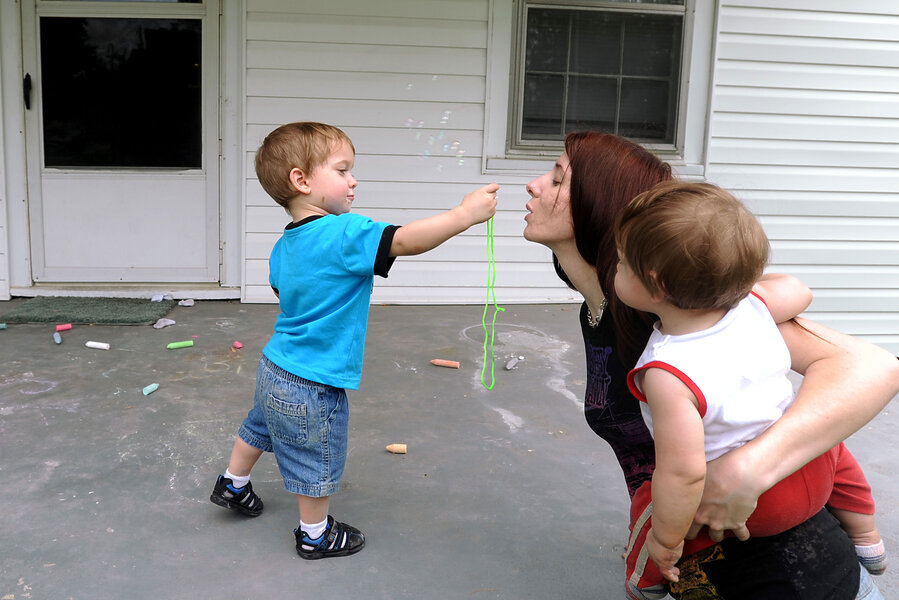Time breastfeeding cover: Attachment parenting vs. an attached parent
Loading...
With all the hullabaloo over Time magazine's cover story on attachment parenting (not to mention the omg-did-you-see-that cover photo of a mom breastfeeding her 3-year-old son) I went to go find my well-worn copy of William Sears’s “The Baby Book.”
Sears is the focus of the Time article, and is often described as the father of American “attachment parenting” – a philosophy, Time’s Kate Pickert writes, that has “helped redefine the modern relationship between mother and baby.”
“The Baby Book” has become a bible of sorts for moms like the ones in her story; moms who breastfeed their children through toddlerhood, who eschew date nights with husbands in favor of nursing, who never leave their children (ever), and who happily give the marital bed over to the baby.
Are you a Helicopter Parent? Take our quiz!
Indeed, attachment parenting, as Ms. Pickert describes it, is based on three tenets: baby wearing (no bouncy seats or strollers here – baby goes in a sling next to mom), breastfeeding (as long as possible) and co-sleeping (baby in bed). As such, this “demanding brand of child rearing” asks a lot of moms, she writes, and also slips into the anti-feminist, since being a good mother in this philosophy seems to require a rather large dose of self-annihilation.
Hmmm.
Where’s that darn book?
Because, I’ll admit it, I consider myself an attachment parent. I cuddled or wore Baby M in a sling for most of her first months. (“Are we going to a Star Wars convention?” one friend asked as I expertly criss-crossed the Moby wrap around my shoulders.) She slept next to our bed in a cradle. I nursed her on demand.
But I don’t see myself in this story.
It’s quite possible, I guess, that I’m just a slacker attachment parent. I mean, ever since the baby was a week old I put her down when I wanted to take a shower. (All that new mom talk about not having time to bathe? I’m telling you, just put the kid down. It can’t move yet.) And although we spent the better part of her first year letting her take naps on us, we never let her sleep in our bed at night. That was our space; no squirmy kiddos allowed.
Still, I carried Baby M enough that one of my grandmothers worried about her future independence. I encountered more than my share of “you’re still nursing her??” To this day I haven’t let her “cry it out.” We spend an awful lot of time snuggling.
And she’s just a perfect, confident, happy little nugget.
Because – and here’s what I feel is lacking from this debate about attachment parenting – we followed our instincts to do what was best for us. As a family. That’s baby, mom, and dad. (Poor dad gets left out of a lot of these debates – an indication, I might venture, of a lot of the problems with parenting conversations these days.)
So, it’d be really easy for me to critique the type of attachment parenting described in the Time magazine article. I could wonder whether the intense, all-consuming emotion focused on one little baby is a way of making up for the emptiness of the privileged class in capitalistic America. I could make some snarky comments about the marital life of people who never go out with one another and share a bed for years with their child.
I could also point out that while “people all over the world” may wear and sleep with their babies, this is far easier to do when you’ve got a village full of other women to whom you can hand the baby when you want a break. (Easier still when you can give the baby to her older sister, who is probably not in school because she’s helping out with this sort of thing.) I could wonder whether American moms see the difference between snuggling their Baby-Bjorned progeny on a walk to Starbucks and the way African women carry babies when they work (and boy, do women in rural Africa work).
But you know, these thoughts of mine really don’t matter for another mom and dad going through that exhausting, beautiful, challenging process of figuring out how to raise their child.
When I finally found “The Baby Book,” I realized that Dr. Sears quite agrees with me on this point.
(And in full disclosure, I’ll admit that the reason this book is so well worn is because it is a hand-me-down. We were more Penelope Leach fans in this house. But I read Sears, too.)
Are you a Helicopter Parent? Take our quiz!
In his first chapter, entitled “Getting Attached: What it Means,” Sears lists three goals for beginning parents. They are: to know your child, to help your child feel right, and to enjoy parenting.
Pretty mainstream, no?
But what about his tenets of attachment parenting?
Turns out that Sears lists five, not three. Here are the two missing from the Time story, which Sears actually puts at the top of his list:
- Connect with your baby early.
- Read and respond to your baby’s cues.
Well then. That’s more like it.
We seem to be all about divisions and partisan lines in the U.S. these days. But as the debate about attachment parenting rages on, perhaps we can remember what we agree upon rather than on what seems so very “other.”
Because when it comes to child rearing, I’m guessing most of us probably want the same thing: healthy, happy, kind kids.
How we get there... well, maybe not so important.
Happy baby-carrying weekend, folks.






